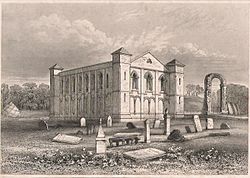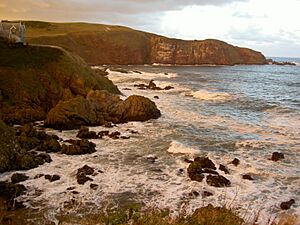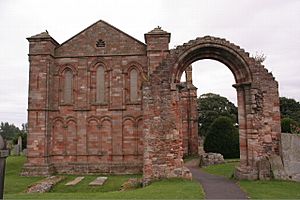Coldingham Priory facts for kids

Coldingham Priory c1850
|
|
| Monastery information | |
|---|---|
| Order | Benedictine |
| Established | x 1139 |
| Disestablished | 1606 |
| Mother house | Durham Cathedral Priory Dunfermline Abbey from 1378 |
| Diocese | Diocese of St Andrews |
| Controlled churches | Aldcambus; Ayton; Berwick Holy Trinity; Berwick St Laurence; Berwick St Mary's; Bondington; Coldingham; Earlston; Ednam; Edrom; Fishwick; Foulden; Gordon; Lamberton; Mordington; Nenthorn; Smailholm; Stichill; Swinton |
| People | |
| Founder(s) | David I of Scotland |
Coldingham Priory was a home for Benedictine monks. It's located on Scotland's southeast coast, in the village of Coldingham, Berwickshire. King David I of Scotland helped start Coldingham Priory. But even before him, in 1098, his brother King Edgar of Scotland gave the land to the Church of Durham. A church was built there in 1100.
The first leader, called a prior, was recorded around 1147. However, the priory likely started much earlier. An even older monastery at Coldingham was founded by St Æbbe around 640 AD. Much of the priory was destroyed by Oliver Cromwell in 1650. Still, some parts remain. The choir section is now the local parish church for Coldingham. It is used by the Church of Scotland.
Contents
Discovering Early Coldingham Priory
Who Was St Æbbe the Elder?
Æbbe's Early Life and Family
Æbbe was born around 615 AD. She came from royal families in Northumbria. Her father was King Æthelfrith of Northumbria, the first king of Northumbria. Her mother, Acha, was a daughter of Ælla of Deira. In 616, her family had to escape to Dál Riata. This happened after her father died in a battle against Rædwald of East Anglia. Æbbe's uncle, Edwin of Northumbria, then became king.
At the court of King Eochaid Buide, Æbbe and her brothers became Christians. King Eochaid's father, Áedán mac Gabráin, knew St Columba. His grandfather, Conall mac Comgaill, even let St Columba build his mission on Iona.
After King Edwin was defeated in 633, Æbbe's brother Oswald took control of Northumbria by 635 AD. This allowed his family to return home.
Abbess Æbbe and Her Monastery

Around 635 AD, King Oswald brought monks from Iona to Lindisfarne. This was to help spread Christianity. Under his guidance, Æbbe first started a monastery at Ebchester. Then she founded another at a place called Urbs Coludi (which means Coldingham). We don't know exactly when these were built. But Æbbe is first mentioned in records around 642 AD.
Her monastery was built on a headland now called Kirk-Hill. It was separated from the outside world by a deep ditch and a tall fence. This religious house lasted about 40 years. It was a "double monastery," meaning both monks and nuns lived there. Æbbe was in charge of everyone.
Around 660 AD, St Æthelthryth, who was queen to Æbbe's nephew, became a nun. She later founded Ely Cathedral. Saint Cuthbert came to Coldingham in 661. He taught the people living in the monastery.
Æbbe sometimes had trouble keeping order. One monk, named Adomnán, predicted the monastery would be destroyed. The abbey at Coldingham burned down in 679 AD, shortly after Æbbe died. It was later rebuilt. Æbbe is remembered as a very religious woman. She helped spread Christianity in Northumbria and beyond. Her special day is August 25th.
Today, only the ditch and some grassy mounds remain at Kirk-hill. There's also a ruined 14th-century church built by later monks. Not much is known about the Coldingham house after it burned down until it was restarted in the 11th century. It seems the house might have become a community of nuns again. By 1100 AD, people greatly respected St Æbbe there. The monastery likely moved from St Abb's Head to its current spot around this time.
St Æbbe the Younger: A Legend
St Æbbe the Younger is a legendary abbess of Coldingham. Stories say that in 870 AD, Danish raiders attacked the coast near the monastery. They then destroyed it.
The Priory's New Beginning
In 1097, Edgar of Scotland took control of Scotland from his uncle, Domnall Bán. Edgar was the son of Malcolm III of Scotland. He attacked and removed King Domnall with help from William II of England. In 1098, Edgar confirmed that the monks of Durham owned the lands of Coldingham. He also attended the dedication of a new church to St Mary in 1100.
In the years that followed, the monks of Coldingham received many land grants. Within fifty years, they had enough land and power to become a Priory.
Life at Coldingham Priory
Life at the priory seemed normal until 1376. But then, in 1378-1379, a big problem happened. The King of Scotland, Robert II, gave Coldingham Priory to another Benedictine monastery, Dunfermline Abbey. He said that English monks were a danger to Scotland. He also claimed they were harming the local area.
The king's decision came after the leader of Coldingham Priory, William Claxton, was accused of being a spy. He was said to be sharing Scottish secrets and taking money out of the country illegally. Coldingham Priory had belonged to Durham Priory for centuries. But at this time, England and Scotland followed different Popes. This made it hard for the English monks to argue their case.
In November 1528, the Earl of Angus stayed at the Priory. He wrote letters about his success against King James V's forces. In October 1544, during a war called the Rough Wooing, a leader named Regent Arran placed six gunners at the Priory to protect it.
Priors of Coldingham
Please see main article:Prior of Coldingham
The End of Monasteries: The Reformation
After the Scottish Reformation, the Priory and its lands became private property. In 1592, Alexander Home, 1st Earl of Home took possession of the Priory. He and his wife moved in and started repairs.
The lands that once belonged to the Priory became a special "lordship" in 1621. This was given to John Stewart, the second son of Francis Stewart, 1st Earl of Bothwell. He was the last "Commendator" (a type of temporary leader) of Coldingham Priory. He received a special document from the King in 1621. This document combined all the Priory's lands into one large area.
Later, the Earl of Home tried to buy the lands from the Stewarts. But he couldn't afford them. In 1636, the people living on the land asked King Charles I of England for help. They felt the Stewarts were treating them unfairly. They wanted the King to become their only superior lord.
During Oliver Cromwell's time, the Homes of Renton took over the lands from the Stewarts. This was to pay off a debt. Today, many people own small parts of what was once the Priory's land.
Coldingham Priory Today
Today, Coldingham Priory is still home to the local Church of Scotland parish church. This church meets inside the restored choir section of the Priory. The church building still has parts from the 13th century. Coldingham Priory is special because it's one of the few large medieval churches in southeast Scotland that is still used today.
Outside the church building, the ruins were in poor condition. They were worn down, overgrown, and at risk of falling apart. But with help from the Heritage Lottery Fund, the site has been improved. The ruins were saved, footpaths were rebuilt, and a neglected area was turned into a community garden. This garden has a monastic theme. It focuses on plants used for cooking, medicine, and scents.
There are also signs that explain the hundreds of years of history at the site. A year-long education program helped schools and community groups learn about the Priory. A group of organizations worked together to get a grant of £237,500. This money helped save the ruins and encourage the community to use the site.
Images for kids
-
Music for the feast day of St Cuthbert from the Coldingham Breviary (1275), British Library
-
Illuminated letter with monks chanting from the Coldingham Breviary (1275), British Library




